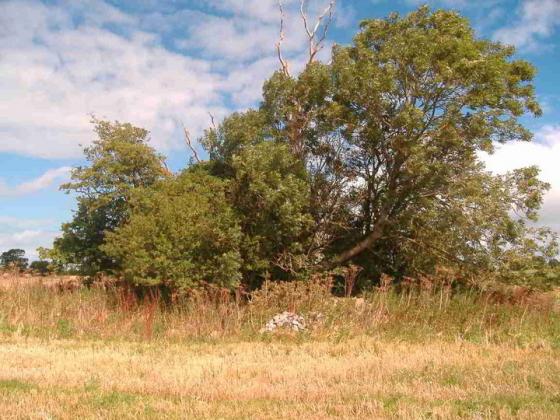






View out to Lough Derg from the Graves

One of the stones strewn around the undergrowth
This has such a wonderful name for a site and is well sign posted from Ballina and Portroe. However when you get there you find that the best thing about the place is the view of the lake. This I think is probably the first megalithic site that I ever saw as this is my ‘home’ site because I only live a few miles away.
Im not sure if any excavation has ever been done of the site but there seems to be stones buried in the undergrowth all over the place and so the exact layout of the site is not apparent.
Taken from a “shortenedNTGazette” by Siobhan Geraghty – I found it a few years ago on a council website.
It has all the evidence of being a Court Cairn, with the court facing the slope down towards the Shannon. It is outside the usual national range of distribution of this monument type, but within the North Tipperary megalith rich area. It is associated in local lore with an incident described in the Cogadh Gael re Gabhll, where a group of Leinster men, visiting Brian Boru in Kincora to pay tribute after the battle of became embroiled in a dispute ostensibly about a chess game, before the battle of . The Leinster men departed, but were caught up with by Brian’s men; a skirmish followed, and the Leinster men were buried there.
The story has probably got a deeper meaning. A small stream with passes under the road close to the viewing point is the boundary between the Dioceses of Cashel and Killaloe; and a large boulder further down slope has the name of ‘Knockaunrilaghin’ (RM19 36 ‘possible cairn’ the small hill of the King of Leinster. This points to the area having a long political significance.
Types of the Ring-Forts Remaining in Eastern Clare (Killaloe, Its Royal Forts, and Their History) by TJ Westropp – “The “Leinstermen’s Graves” were described to me in 1892 as “a fine circle of stones.” This is most deceptive. They stand on a high heathery shoulder of Thountinna with a splendid view over most of Lough Derg, Inisealtra with its round tower and churches and the hills on the border of Galway. In this lonely spot (hovered over by countless hawks hanging on the wind) is a line of small slate slabs 42 feet long, the largest “pillar” being only 3 feet 6 inches high, by 2 feet 6 inches square, the others usually under 3 feet high.
There is a low mount 17 feet to the north of the “chief pillar. A sort of fenced avenue runs into the slightly enclosed space between it and the alignment.”
This legend seems to have numerous different versions. The local legend being that they were buried on the hills because it looks east to leinster. However the stones are actually on the western side. These stones have been confirmed as being Bronze Age so this is a much a more recent story.
I’ve also thought this legend may have something to do with the movement of the sun, it rises in the east (this being the king of leinster) and dies looking to the west over the Slieve Beragh in Co. Clare.
This is the legend i took from the website www.athomefirst.com:
Sometime during the years when Brian was King of Munster, a royal wedding was to be held near Limerick. The King of Leinster, allied with the Limerick Vikings, was invited to attend, and, with a small contingent of his army set out to cross northern County Tipperary about 30 miles of Munster—enemy territory—to reach Limerick and the wedding. The route selected would avoid towns as much as possible, to avoid detection and confrontation with Brian’s Munstermen. It was to cross the highest of the Arra Mountains, Tountinna, 1,500 feet high, where there were some old slate mines and a few farms, but no villages until reaching the River Shannon at Ballina, not far from the Limerick border.
Brian Boru’s castle was atop the hilly town of Killaloe just across the Shannon from Ballina. The view from the castle looked across the river toward Ballina and the Arra Mountains. Gormlaith, bride of Brian, was at home in Killaloe when she received word of the wedding guests underway from Leinster. It so happened that Gormlaith was none other than mother of Sitric Silkenbeard, Viking King of Dublin, mortal enemy of Brian Boru and the Irish of Munster. Although Brian was at that moment away from Killaloe, Gormlaith knew an opportunity when she saw one, and proved to be no shrinking violet. Calling on her loyal friends in Dublin, Gormlaith ferreted the travel plans of the King of Leinster and his militia and planned a surprise welcome for them when they neared the end of their journey.
As the tired wedding guests traversed the heights of Tountinna and came into sight of Lough Derg, the great lake of the Shannon, and the Slieve Bernagh mountains to the west, they were set upon by the murderous attack of a superior force led by a fierce woman. No mercy was shown. The entire wedding party—including the King of Leinster—was slain on the slopes of Tountinna. They were buried on the spot, and the graves marked with several medium sized blocks of native stone.
This story doesn’t make complete sense to me and seems to contradict itself, but I will find out more about it.






























































